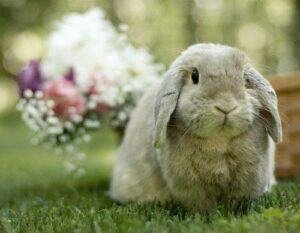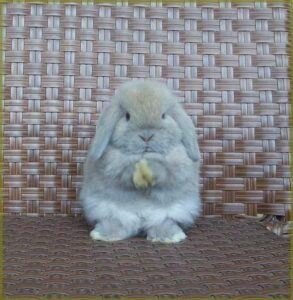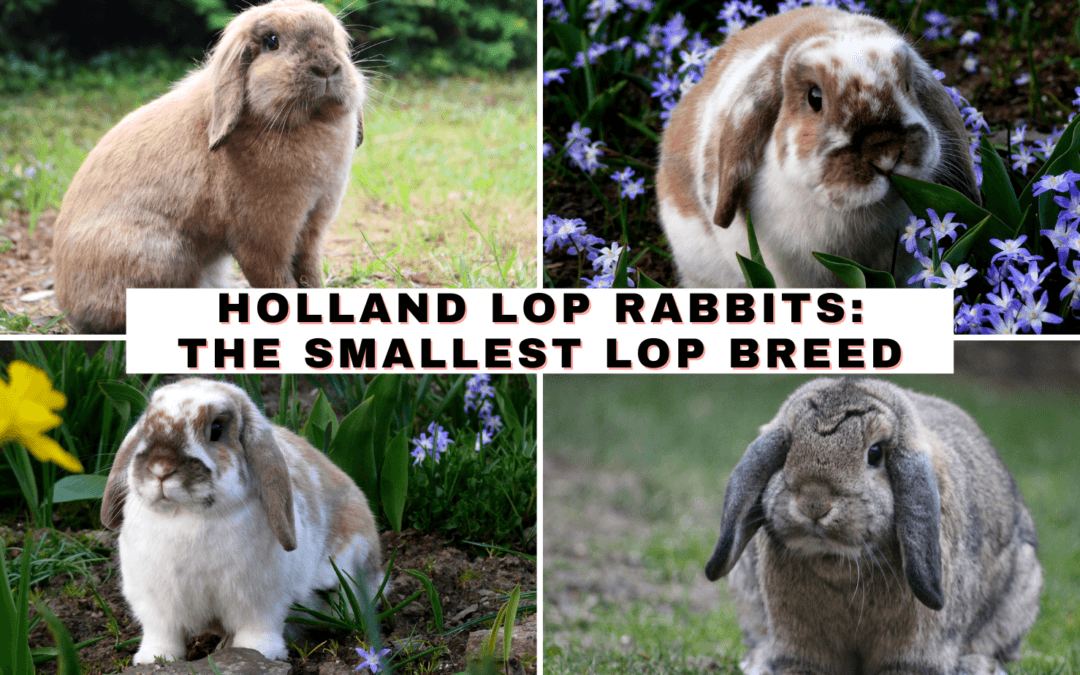Holland lop rabbits are among the most popular breeds because of their charm. They look like French lops but are easier to handle due to their miniature size. Thankfully, their short coats and light nails require less grooming than other rabbit breeds. If you plan to get a Holland lop, you are in the right place! In this post, you will know about its features, care needs, and behavior. Although Holland lop rabbits are low maintenance, they need attention to grow healthy.

Holland Lop
Facts About Holland Lop Rabbits
| Body Size | Dwarf |
| Body Weight | 2 to 4 pounds |
| Body Shape | Compact |
| Life Span | 6 to 8 years |
| Colors | Self, agouti, broken, pointed white, shaded, tan, ticked, wide band |
| Rarity | Common |
| Similar Breeds | French lop, Netherland Dwarf rabbit |
| Best Suited for | New owners, families with children, singles |
| Origin | Netherlands |
Background and History
To create a small version of the French Lop, Adriann de Cock of the Netherlands crossbred rabbits. For the breeding procedure, he used the French lop and the Netherland Dwarf rabbit. The first breeding commenced in 1949 when he used a female Netherland Dwarf and a male French lop. Unfortunately, the offspring were too large, leading to their death. The same fate also happened to their mother.
Discouraged, de Cock stopped the breeding for years. However, he decided to resume the breeding process in 1951. This time, he used a male Netherland Dwarf rabbit and a female Frech Lop. It succeeded after the mother birthed six agouti litters with standard ear positions.
In 1952, de Cock aimed to create ear-lopped offspring, so he introduced the breed with the Sooty Fawn. Although the offspring was not as large as before, they had the desired lopped ears. It took 11 years before he announced the standard weight of Holland lop, which was 4.4 lbs.
By 1964, the Dutch breeders recognized this breed. They also introduced it to other countries. It even appeared and became popular in the United Kingdom from 1965 to 1975. With the help of Aleck Brooks, Holland lop rabbits arrived in the United States in 1976. The American Rabbit Breeders Association (ARBA) recognized this breed after three years.
Holland lop rabbits became popular both in the U.S. and U.K. They are one of the top five most popular breeds today.
Features of Holland Lop Rabbits
Body Size

Since Holland lop’s average weight is only 2 to 4 lbs, it is categorized as a dwarf rabbit. It is 4 to 5 inches tall and 10 to 12 inches long when stretched out. The ratio of its robust and compact body to its head is about 2:1. A Holland lop’s legs can be categorized into six types. They are the ideal, pinched, narrow, thin, thin long bone, and pinched and narrow.
When at rest, this rabbit poses like a cat. It usually rests on its hind legs than its two front feet. Its crown is broad and thick. In shows, the ideal appearance of a Holland lop is muscular with deep hindquarters. Its legs must also be short, thick, and heavily boned.
The most distinctive trait of a Holland lop is its ears. Since they are from French lop and Sooty Fawn, they are almond shape. These ears can grow up to four inches. Additionally, the short, round noses of the Holland lop rabbits also make them more charming. Usually, they have black or brown eyes.
Coat
Dense and medium in length, the Holland lop rabbit’s fur is easy to maintain. It is also glossy and smooth to the touch. Its coat is available in a wide variety of colors. In fact, they are categorized into seven patterns. These are self, agouti, broken, pointed white, shaded, tan, ticked, and wide band. Below are the colors of the Holland lop rabbits:
| Categories | Colors |
| Self | Black, chocolate, ruby-eyed white, blue-eyed white, blue, lilac |
| Agouti | Chocolate, chinchilla, chocolate chinchilla, chestnut, squirrel, opal, lynx |
| Broken | Any color with white |
| Pointed white | Black, chocolate, blue, lilac |
| Shaded | Smoked pearl, Siamese sable, sable point, seal, tortoise (chocolate, black, lilac, or blue) |
| Tan | Otter (chocolate, black, blue, or lilac) |
| Ticked | Chocolate, lilac, blue, silver-tipped or gold-tipped steels in black |
| Wide band | Tricolors, fawn, cream, orange, frosty, red |
Temperament and Behavior
Holland lop rabbits can quickly get along with their owners because they are docile. Unsurprisingly, children also love them since they are easy to carry and handle. Since this breed is playful and active, they prefer to have some time outdoors. However, ensure your lawn has a secured fence because they are prone to escape due to curiosity.
These adorable creatures also love to hop on their owners’ laps to get petted and cuddled. As observed by many, the males are more affectionate than the females. Although does are also sweet, they can get feisty and shy when they want to breed. But they become calmer as they grow.
Like other breeds, Holland lops will appreciate having simple toys inside their enclosures. They keep them busy and occupied. In giving them toys, ensure they don’t have harmful chemicals. You can also introduce these bunnies to other rabbits since they are sociable.
Grooming Holland Lop Rabbits
Compared to other rabbit breeds, the Holland lop rabbit is more manageable to groom due to its short fur. You can brush its coat weekly using a fine comb. But if it’s molting, you must groom its fur more frequently to avoid ingestion. A Holland lop typically sheds two to three times a year, lasting up to six weeks to two months.
You don’t have to brush all over this rabbit’s coat for shows. Using a fine comb, gently brush the sticky spots. Since a buck tends to get dirtier, you must spend more time grooming it. You can also use a grooming spray on the rabbit’s coat. As a reminder, never use any chemicals on their coat. A soft brush is handy for removing dead fur. In terms of stains, use peroxide or white alcohol. Rinse-less rabbit shampoo is also helpful. Simply rub a small amount on the stained coat gently with a clean cloth.
To keep your rabbit healthy, nail trimming is also vital in grooming a Holland lop rabbit. Luckily, this rabbit’s nails are easier to trim since they are lighter than other rabbit breeds. Since it loves attention, you won’t have a rough time flipping it around. As much as possible, use small trimmers to prevent injuring the rabbits’ nails.
Proper Diet

As a herbivore, the Holland lop rabbits’ diet consists of 70% high-quality hay. You can give them different types of hay: alfalfa, timothy, orchard grass, and oat hay. Feeding hay will keep their digestive system functioning and their teeth trimmed.
Besides hay, you can also feed these bunnies some leafy greens, fruits, and pellets. To keep them hydrated, ensure they have an ample water supply in their enclosures. If you have baby bunnies, never give them adult food. They need protein, calcium, and fiber in their mother’s milk.
When choosing the right pellet, you must consider its nutritional composition. It must be high in fiber and low in protein. It also helps in adding minerals and vitamins to the rabbits’ diet. As much as possible, never give foods that are in fats since they may cause obesity.
Habitat
A Holland lop rabbit can live indoors or outdoors. Since it has a small body, the hutch doesn’t need a vast space. It can be at least a four-foot square. For its width, ensure it is one and a half times the length. For the area, it must be three times the body length of the rabbit. You will also need to provide ample space in its enclosure where it can run.
In making a hutch, avoid using wire floors because they may result in sore hocks on your rabbit. If you let a Holland lop play outdoors, keep away all the cables it can chew. Also, ensure it is safe from predators like dogs and coyotes.
Health Issues of Holland Lop Rabbits
Uterine Cancer
Uterine cancer is common in unneutered does cause by hormonal imbalance. Unfortunately, it is typically experienced by 60% of female rabbits above three years old. The signs of uterine cancer are an abnormality in the oestrus cycle, weight loss, and bloody urine. You may also notice that the rabbit’s organ is failing, leading to kidney or liver disease.
A blood transfusion is needed for uterine bleeding since it may be life-threatening. The treatment for this condition is the surgical removal of the uterus and ovaries. If surgery is not done, there is a smaller chance for the rabbit to survive.
Cystitis
There are a couple of bladder problems that a rabbit can experience. One of the most common is cystitis. It is the inflammation of the bladder’s lining caused by bacteria. If not for bacteria, it can also be caused by infection, tumor, bladder stones, or failure to empty the bladder.
Some of the symptoms that a rabbit suffering from cystitis are the following:
- Difficulty passing urine
- Blood in the urine
- Urination in inappropriate places
- Urine scalding in different parts of the body
- Loss of appetite
- Lethargic
- Dehydrated droppings
- Pain when the abdomen is pressed
- Increased body temperature
To treat this condition, the vet must prescribe an antibiotic to the bunny. The rabbit must be sedated for urine scalding to clean the area carefully. If it’s obese, it needs to undergo a weight loss program. For the removal of bladder stones, surgery is necessary. If the tumor cannot be removed due, euthanasia is an option.
Frequently Asked Questions
Is a male Holland lop better than a female?
In the case of temperament, a male Holland lop is friendlier than a female. Bucks are good at expressing their affection to their owners. Although does are also friendly, they tend to get shy and nippy when they want to breed. However, they become more docile and calm as they mature.
Are Holland lop rabbits intelligent creatures?
Yes, Holland lop rabbits are intelligent. So, they are easy to teach some tricks, especially potty and litter training. These bunnies are also prone to escape from their owners because of their curiosity. Before letting them roam in your garden, ensure it is safe enough.
How much does a Holland lop cost?
This breed is inexpensive, like other rabbit breeds. The average cost is $40. However, it can range from $20 to $400. Bunnies for shows are more expensive since they are healthier. But you should purchase from legitimate breeders to ensure that it is well-bred.
Conclusion
Holland lop rabbits are adorable, so many owners want to have them as pets. Aside from their features, they are also even-tempered and amicable. But like any other rabbit breed, you must pay attention to their diet and grooming. If not taken care of, Holland lops may suffer from different health issues.
Read More
French Lop Rabbits: The Giant Lop Breed
Lop Eared Rabbit: A Beginner’s Guide



